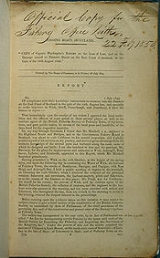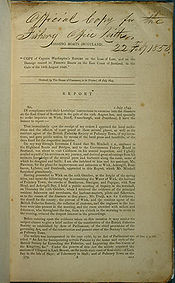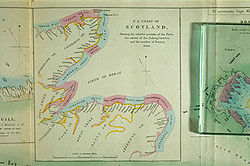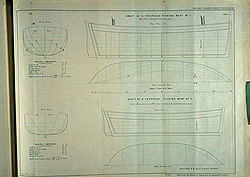
Moray Firth fishing disaster
Encyclopedia
The Moray Firth fishing disaster of August 1848 was one of the worst fishing disaster
s in maritime history on the east coast of Scotland
, and was caused by a severe storm
that struck the Moray Firth
. The event led to widespread improvements to harbours and significant changes to the design of fishing boats over the remainder of the 19th century.
 Scottish fishing boats of the late 18th and early 19th centuries were generally small sail boats with open hulls that mainly fished close to shore. The shallow design of the boats allowed them to be launched by their crew from beach
Scottish fishing boats of the late 18th and early 19th centuries were generally small sail boats with open hulls that mainly fished close to shore. The shallow design of the boats allowed them to be launched by their crew from beach
es or small harbours, but their open hull provided little shelter for the crew and made them susceptible to swamping and capsize
in rough seas.
Dutch
fishermen had been fishing for herring
in the North Sea
from the 15th century, and had developed a large scale system of "Buss" fishing
in deeper waters using large boats which stayed at sea for several weeks and cured
the fish aboard the vessels. To compete with this method, the Government of the day introduced a bounty system which initially rewarded fishermen for using larger vessels, but later paid the bounty based on the size of catch. This led to a gradual increase in the size of fishing vessel operating from the East Coast harbours, although open hulls were still favoured because this allowed the maximum possible catch to be accommodated.
 The weather on the afternoon of 18 August was favourable, promising good fishing and, from Wick to Stonehaven
The weather on the afternoon of 18 August was favourable, promising good fishing and, from Wick to Stonehaven
, around 800 boats set out to sea to gather the day's herring catch. By midnight the weather was deteriorating rapidly with strengthening winds and increasingly heavy seas. Many skippers decided to haul their nets and make for shelter. During the course of the following storm
, 124 boats were lost, many while trying to enter harbour, and 100 fishermen lost their lives, leaving behind 47 widows and 161 children.
In the aftermath of the storm, the Government appointed Captain John Washington of the Admiralty
to conduct an inquiry into the tragedy and make recommendations for safety improvements in the fishing industry. His report, entitled Report on the loss of life, and damage caused to fishing boats on the East Coast of Scotland, in the gale of 19 August 1848, was presented to the House of Commons
in 1849. Washington came to two main conclusions: firstly, that the open-hulled design of the fishing boats was deficient, leading to their susceptibility to swamping in heavy seas, and was a significant factor in the tragedy; secondly, that there was a shortage of good quality harbours accessible to fishing vessels in all tidal conditions.
 Washington's recommendations led to a programme of improvements to the many small harbours around the east coast of Scotland. The Fishery Board for Scotland also encouraged the introduction of decked vessels. The main types of boat used for herring fishing on the east coast were the Fifie
Washington's recommendations led to a programme of improvements to the many small harbours around the east coast of Scotland. The Fishery Board for Scotland also encouraged the introduction of decked vessels. The main types of boat used for herring fishing on the east coast were the Fifie
, and the smaller Skaffie
which was common around the Moray Firth. Fishermen initially resisted the introduction of decks because it reduced the space available for the catch, but they also feared that a deck would increase the risk of men being swept overboard.
Gradually, the provision of decks on the boats became more common, which led to a further increase in boat size to compensate for the reduced space for the catch. In addition to decks, new boats were being built with a small forecastle
in the bow, which contained bunks and provided shelter for the fishermen. This evolution in boat design led to the introduction of the Baldie
in 1860 and the Zulu
in 1879. By the end of the century all the east coast fishing vessels were fully decked.
Disaster
A disaster is a natural or man-made hazard that has come to fruition, resulting in an event of substantial extent causing significant physical damage or destruction, loss of life, or drastic change to the environment...
s in maritime history on the east coast of Scotland
Scotland
Scotland is a country that is part of the United Kingdom. Occupying the northern third of the island of Great Britain, it shares a border with England to the south and is bounded by the North Sea to the east, the Atlantic Ocean to the north and west, and the North Channel and Irish Sea to the...
, and was caused by a severe storm
Storm
A storm is any disturbed state of an astronomical body's atmosphere, especially affecting its surface, and strongly implying severe weather...
that struck the Moray Firth
Moray Firth
The Moray Firth is a roughly triangular inlet of the North Sea, north and east of Inverness, which is in the Highland council area of north of Scotland...
. The event led to widespread improvements to harbours and significant changes to the design of fishing boats over the remainder of the 19th century.
Fishing history

Beach
A beach is a geological landform along the shoreline of an ocean, sea, lake or river. It usually consists of loose particles which are often composed of rock, such as sand, gravel, shingle, pebbles or cobblestones...
es or small harbours, but their open hull provided little shelter for the crew and made them susceptible to swamping and capsize
Capsize
Capsizing is an act of tipping over a boat or ship to disable it. The act of reversing a capsized vessel is called righting.If a capsized vessel has sufficient flotation to prevent sinking, it may recover on its own if the stability is such that it is not stable inverted...
in rough seas.
Dutch
Netherlands
The Netherlands is a constituent country of the Kingdom of the Netherlands, located mainly in North-West Europe and with several islands in the Caribbean. Mainland Netherlands borders the North Sea to the north and west, Belgium to the south, and Germany to the east, and shares maritime borders...
fishermen had been fishing for herring
Herring
Herring is an oily fish of the genus Clupea, found in the shallow, temperate waters of the North Pacific and the North Atlantic oceans, including the Baltic Sea. Three species of Clupea are recognized. The main taxa, the Atlantic herring and the Pacific herring may each be divided into subspecies...
in the North Sea
North Sea
In the southwest, beyond the Straits of Dover, the North Sea becomes the English Channel connecting to the Atlantic Ocean. In the east, it connects to the Baltic Sea via the Skagerrak and Kattegat, narrow straits that separate Denmark from Norway and Sweden respectively...
from the 15th century, and had developed a large scale system of "Buss" fishing
Herring Buss
A herring buss was a type of sea-going fishing vessel, used by Dutch herring fishermen in the 15th through early 19th centuries.The buss ship type has a long history...
in deeper waters using large boats which stayed at sea for several weeks and cured
Curing (food preservation)
Curing refers to various food preservation and flavoring processes, especially of meat or fish, by the addition of a combination of salt, nitrates, nitrite or sugar. Many curing processes also involve smoking, the process of flavoring, or cooking...
the fish aboard the vessels. To compete with this method, the Government of the day introduced a bounty system which initially rewarded fishermen for using larger vessels, but later paid the bounty based on the size of catch. This led to a gradual increase in the size of fishing vessel operating from the East Coast harbours, although open hulls were still favoured because this allowed the maximum possible catch to be accommodated.
The storm and its aftermath

Stonehaven
Stonehaven is a town in Aberdeenshire, Scotland. It lies on Scotland's northeast coast and had a population of 9,577 in 2001 census.Stonehaven, county town of Kincardineshire, grew around an Iron Age fishing village, now the "Auld Toon" , and expanded inland from the seaside...
, around 800 boats set out to sea to gather the day's herring catch. By midnight the weather was deteriorating rapidly with strengthening winds and increasingly heavy seas. Many skippers decided to haul their nets and make for shelter. During the course of the following storm
Storm
A storm is any disturbed state of an astronomical body's atmosphere, especially affecting its surface, and strongly implying severe weather...
, 124 boats were lost, many while trying to enter harbour, and 100 fishermen lost their lives, leaving behind 47 widows and 161 children.
In the aftermath of the storm, the Government appointed Captain John Washington of the Admiralty
Admiralty
The Admiralty was formerly the authority in the Kingdom of England, and later in the United Kingdom, responsible for the command of the Royal Navy...
to conduct an inquiry into the tragedy and make recommendations for safety improvements in the fishing industry. His report, entitled Report on the loss of life, and damage caused to fishing boats on the East Coast of Scotland, in the gale of 19 August 1848, was presented to the House of Commons
British House of Commons
The House of Commons is the lower house of the Parliament of the United Kingdom, which also comprises the Sovereign and the House of Lords . Both Commons and Lords meet in the Palace of Westminster. The Commons is a democratically elected body, consisting of 650 members , who are known as Members...
in 1849. Washington came to two main conclusions: firstly, that the open-hulled design of the fishing boats was deficient, leading to their susceptibility to swamping in heavy seas, and was a significant factor in the tragedy; secondly, that there was a shortage of good quality harbours accessible to fishing vessels in all tidal conditions.

Fifie
The Fifie is a design of sailing boat developed on the east coast of Scotland. It was a traditional fishing boat used by Scottish fishermen from the 1850s until well into the 20th century...
, and the smaller Skaffie
Scottish east coast fishery
The Scottish east coast fishery has been in existence for more than a thousand years, spanning the Viking period right up to the present day.-A brief history:...
which was common around the Moray Firth. Fishermen initially resisted the introduction of decks because it reduced the space available for the catch, but they also feared that a deck would increase the risk of men being swept overboard.
Gradually, the provision of decks on the boats became more common, which led to a further increase in boat size to compensate for the reduced space for the catch. In addition to decks, new boats were being built with a small forecastle
Forecastle
Forecastle refers to the upper deck of a sailing ship forward of the foremast, or the forward part of a ship with the sailors' living quarters...
in the bow, which contained bunks and provided shelter for the fishermen. This evolution in boat design led to the introduction of the Baldie
Scottish east coast fishery
The Scottish east coast fishery has been in existence for more than a thousand years, spanning the Viking period right up to the present day.-A brief history:...
in 1860 and the Zulu
Scottish east coast fishery
The Scottish east coast fishery has been in existence for more than a thousand years, spanning the Viking period right up to the present day.-A brief history:...
in 1879. By the end of the century all the east coast fishing vessels were fully decked.
See also
- Maritime history of ScotlandMaritime history of ScotlandThe Maritime history of Scotland involves events including shipping, ports, navigation, and seamen, as well as marine sciences, exploration, trade, and maritime themes in the arts of Scotland.-Royal Scots Navy:...
- Eyemouth DisasterEyemouth DisasterThe Eyemouth disaster was a severe European windstorm that struck the southern coast of Scotland, United Kingdom, specifically Berwickshire, on 14 October 1881. 189 fishermen died, most of whom were from the village of Eyemouth...
- Scottish East Coast FisheryScottish east coast fisheryThe Scottish east coast fishery has been in existence for more than a thousand years, spanning the Viking period right up to the present day.-A brief history:...

